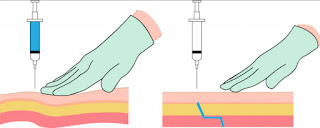Overview Of Intramuscular (IM) Injection
Intramuscular (IM) injection is the method of installing medications into the depth of the bulk of specifically selected muscles. The medication is deposited deep into the muscle mass, past the dermis and subcutaneous tissue, and into the very deepest layers of the muscle, where the rich blood supply allows for rapid and full absorption bypassing the first-pass metabolism. Bulky muscles have good vascularity.
Injected drugs quickly reach the systemic circulation less rapid but generally longer lasting than those obtained from IV administration. Slow drug absorption leading to a sustained-release (SR) effect can be achieved with highly insoluble drugs or formulations that are oleaginous or particulate. Aqueous or oleaginous solutions or reconstitutable powder or colloidal suspensions or emulsions or suspensions of drugs may be administered intramuscularly. Any drugs that are nonirritant and soluble may be given IM during an emergency scenario. Drugs in aqueous solution are absorbed more rapidly than those in oleaginous preparations or in suspensions.
Read Also: Overview Of Route Of Drug Administration
Anatomy Of Muscles
They are striated muscle fibers that lie beneath the subcutaneous (SC) layer. Not every muscle can be used. This is because some muscles are located close to major arteries or nerves. Damage to those can be fatal. That is why, depending on the age and drug including drug volume, only a few muscles can be used.
Deltoid Muscle Of The Arm
Use mostly for vaccines. To locate this site, feel for the bone (acromion process) that’s located at the top of the upper arm. The correct area to give the injection is two finger widths below the acromion process. At the bottom of the two fingers, will be an upside-down triangle. Give the injection in the center of the triangle. Up to 2 mL of the drug may be injected into the upper arm
Vastus Lateralis Muscle Of The Thigh
Use when other sites are not available or for self medication. Divide the upper thigh into three equal parts. Locate the middle of these three sections. The injection should go into the outer top portion of this section.
Ventrogluteal Muscle Of The Hip
The safest sites for adults and children above 7 years of age. It is deep and not close to any major blood vessel. Not suitable for self medication. Place the heel of your hand on the hip of the person receiving the injection, with the fingers pointing towards their head. Position the fingers so the thumb points toward the groin and you feel the pelvis under your pinky finger. Spread your index and middle fingers in a slight V shape, and inject the needle into the middle of that V.
Dorsogluteal Muscles Of The Buttocks
5 to 7.5 cm below the iliac crest located at the upper outer quadrant within the buttocks. Up to 5 mL of the drug may be injected into the gluteal medial muscle of each buttock.
Equipment
1. 20-25 gauge syringe with a needle length of 16 to 38 mm
2. Filter needle
3. Alcohol-based antiseptic solution
4. The correct drug in an appropriate dose
5. Dry cotton swab
6. Self-adhesive bandage
7. Needle disposal unit
Site Selection
- Infants- vastus lateralis
- Children- vastus lateralis and deltoid
- Adults- ventrogluteal and deltoid
Drug Volume
- 2 ml or less- deltoid injection
- 2 to 5 ml- ventrogluteal injection
Needle Length
- Vastus lateralis- 16 to 25 mm
- Deltoid- 16 to 32 mm (children), 25 to 38 mm (adults)
- Ventrogluteal- 38 mm
Procedure
1. Clean the hands
2. Wear hand gloves
3. Clean the site
4. Fix the needle to the syringe
5. Prepare the right drug at the right amount
6. Aspirate the syringe when the needle is cover with the cap
7. Withdraw the drug
8. Insure the needle in the muscle at 90 degree angle and aspirate. Intramuscular injections are administered at a 90 degree angle
9. Inject the drug into the muscle
10. Remove syringe and dispose off for disposable
11. Apply pressure on injection site
The Z-track method is a type of IM injection technique used to prevent tracking (leakage) of the medication into the subcutaneous tissue (underneath the skin).
 |
| Intramuscular (IM) injection |
During the procedure, skin and tissue are pulled and held firmly while a long needle is inserted into the muscle. After the medication is injected, the skin and tissue are released. When you insert a needle into the tissues, it leaves a very small hole, or track. Small amounts of medication can sometimes leak backwards through this track and be absorbed into other tissues. Pulling the skin and tissue before the injection causes the needle track to take the shape of the letter “Z,” which gives the procedure its name. This zigzag track line is what prevents medication from leaking from the muscle into surrounding tissue. Use only for hip (ventrogluteal) and thigh (vastus lateralis muscle.

Comments
Post a Comment
Please have your say